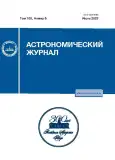Orbital Period Variations of the Eclipsing Binaries RX Ari and V449 Oph
- 作者: Khaliullina A.I.1
-
隶属关系:
- Sternberg Astronomical Institute, Moscow State University
- 期: 卷 100, 编号 6 (2023)
- 页面: 488-499
- 栏目: Articles
- URL: https://journals.rcsi.science/0004-6299/article/view/139088
- DOI: https://doi.org/10.31857/S000462992306004X
- EDN: https://elibrary.ru/ZEUYDM
- ID: 139088
如何引用文章
全文:
详细
The variations in the orbital period of the eclipsing binaries RX Ari and V449 Oph have been analyzed. It has been shown that the variations in the period of RX Ari can be represented by a superposition of a secular period increase and two cyclic variations. The secular increase in the period can be explained by the exchange of matter between the components. Cyclic variations in the period may be due to the presence of two additional bodies in the system, or only one additional body in combination with the magnetic activity of the main component. The variations in the orbital period of V449 Oph can be represented with almost equal accuracy either as a superposition of two cyclic variations, or as a superposition of a secular period increase and two cyclic variations. The obtained parameters of the light-time effects and magnetic quantities lead to the conclusion that it is preferable to use linear elements to represent the variations in the orbital period of V449 Oph. In this case, one of the cyclic variations can be a consequence of the light-time effect, and the second one can be a consequence of the magnetic activity of the secondary component. Both types of variations can also be a consequence of the magnetic activity of the secondary component.
作者简介
A. Khaliullina
Sternberg Astronomical Institute, Moscow State University
编辑信件的主要联系方式.
Email: hfh@sai.msu.ru
119991, Moscow, Russia
参考
- C. Hoffmeister, Astron. Nachr. 235, 195 (1934).
- F. Lause, Astron. Nachr. 266, 237 (1938).
- G. E. McCluskey, Astron. J. 71, 527 (1966).
- R. E. Wilson and J. B. Rafert, Astron. and Aph. Suppl. Ser. 42, 195 (1980).
- W. Götz and W. Wenzel, Mitt. Veränder. Sterne 1, №504 (1960).
- T. J. Herczeg, IAU Symp. 88, 89 (1980).
- O. Morgenroth, Astron. Nachr. 250, 75 (1933).
- S. Piotrowski, Acta Astron. ser. c 2, 79 (1934).
- R. Szafraniec, Acta Astron. 22, 273 (1972).
- E. M. Halbedel, Publ. Astron. Soc. Pacif. 96, 98 (1984).
- R. W. Hilditch and G. Hill, Mem. Roy. Astron. Soc. 79, 101 (1975).
- A. D. Mallama, Astrophys. J. Suppl. 44, 241 (1980).
- M. A. Svechnikov and Eh. F. Kuznetsova, Vizier On-line Data Catalog: Approximate elements of eclipsing binaries (1990).
- B.R.N.O. Project – Eclipsing Binaries database, http://var2.astro.cz/EN/brno/index.php.
- И. Халиуллина, Х. Ф. Халиуллин, Астрон. журн. 61, 393 (1984).
- Д. Я. Мартынов, в кн.: М. С. Зверев, Б. В. Кукаркин, Д. Я. Мартынов, П. П. Паренаго, Н. Ф. Флоря, В. П. Цесевич Переменные звезды (Гостехиздат, т. 3, стр. 464–490, 1947).
- P. P. Eggleton, Astrophys. J. 268, 368 (1983).
- Х. Ф. Халиуллин, Астрон. журн. 51, 395 (1974).
- Z. Eker, F. Soudugan, E. Soydugan, S. Bilir, E. Yaz Gökçe, I. Steer, M. Tüysüz, T. Şenyüz, and O. Demircan, Astron. J. 149, 131 (2015).
- J. H. Applegate, Astrophys. J. 385, 621 (1992).
- А. И. Халиуллина, Астрон. журн. 96, 196 (2019).
- A. F. Lanza, M. Rodono, and R. Rosner, Monthly Not. Roy. Astron. Soc. 296, 893 (1998).
- A. F. Lanza and M. Rodono, Astron. and Astrophys. 349, 887 (1999).
补充文件

















